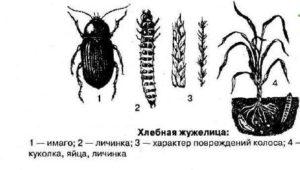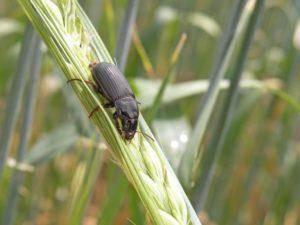Bread ground beetle: how to defeat the black beetle on the ears
Among the harmful beetles there are many different pests of bread. Some live in barns and storage areas, but there are those who eat the ears right in the field. In the steppes and other places where drought often occurs, the grain ground beetle loves to live and eat.
Content
What does the grain beetle look like: photo
Description of the grain beetle
Name: Bread ground beetle or humpback peun
Latin: Zabrus gibbus Fabr.=Z. Tenebrioides GoezeClass: Insects - Insecta
Squad: Coleoptera - Coleoptera
Family: Ground beetles - Carabidae
 | Habitats: | fields and steppes |
 | Dangerous for: | cereal crops |
 | Means of destruction: | processing before planting, agricultural technology |
The grain beetle is a common oligophage. The second name of the beetle is hunchbacked peun. The dietary preferences of this species of beetle are very specific - cereals. He eats:
- wheat
- oats;
- barley;
- corn;
- wheatgrass;
- bluegrass;
- wheatgrass;
- foxtail;
- timothy.
Appearance and life cycle
Medium-sized beetle, up to 17 mm long. The grain ground beetle is pitch black, in adults the legs are slightly red. The head is large in relation to the body, the whiskers are short.
Beetles hatch at the beginning of summer, when winter wheat begins to bloom.
They actively feed at temperatures from +20 to +30 degrees. By the onset of a stable heat in the summer, the grain beetles are already full and hide in the cracks of the ground, stacks and under the trees.
Those individuals that ate less during the hot season come to the surface on cloudy days. The next activity of the beetle begins in mid-August and lasts for 2 months.
Beetle annual generation:
- eggs are small, up to 2 mm;
- larvae are brown, thin, long;
- pupae are white, similar to adults.
Distribution and habitation
The grain beetles prefer to grow and develop in the south of Russia, in the conditions of the steppe and forest-steppe. For normal wintering, it is necessary that at a depth of 20 cm the soil does not freeze stronger than -3 degrees.
Pests are both adults and larvae. Adults feed on grains of various crops. The larvae eat soft spikelets and young green leaves. They cut them off and grind them in the burrow. One beetle can eat 2-3 grains per day.
Unfavorable environment
The grain ground beetle is quite capricious in relation to living conditions. She loves high humidity, so she is very active after rain and irrigation.
Ground beetles are finicky with respect to conditions:
- larvae die during drought;
- eggs do not develop at low humidity;
- die when temperatures drop in autumn;
- high temperature in spring causes death.
How to protect grain and plantings
The process of planting and caring for cereals must be carried out in such a way as to protect the future crop. These include:
- Treatment of grain before planting with special insecticide-based disinfectants.
- Destruction of carrion and weeds to reduce the number of bugs that accumulate.
- Plowing fields after harvest and deep cultivation.
- Effects of temperature and drying of grain.
- Timely field surveys.
- Changes of places of crops of winter wheat.
- Timely harvesting of grain, with maximum productivity, without losses.
- Embedding plant residues in the ground, so as not to create a favorable environment.
Conclusion
The grain beetle is a pest of cereal crops. He loves especially young wheat, eating juicy grains. With the massive spread of pests, the entire crop is at risk.
Beetles hibernate in the soil, prefer warm regions and high humidity. They are active twice, at the beginning of spring and towards the end of the season. At this time, the sun is no longer so active, and there is just plenty of food.
Previous
